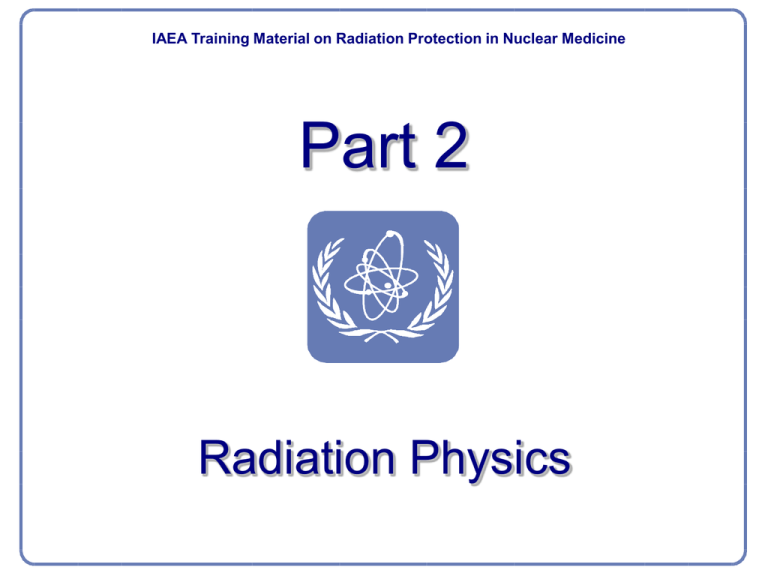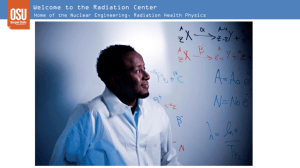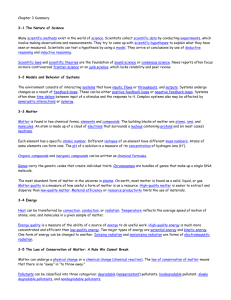Radiation Protection in Nuclear Medicine
advertisement

IAEA Training Material on Radiation Protection in Nuclear Medicine Part 2 Radiation Physics Objective To become familiar with the basic knowledge in radiation physics, dosimetric quantities and units to perform related calculations, different types of radiation detectors and their characteristics, their operating principles, and limitations. Nuclear Medicine Part 2: Radiation Physics 2 Content Atomic structure Radioactive decay Production of radionuclides Interaction of ionizing radiation with matter Radiation quantities and units Radiation detectors Note: Radiation units & quantities are in the process of undergoing consensus through ICRU and IAEA. There may be changes necessitating incorporation in this CD. Nuclear Medicine Part 2: Radiation Physics 3 IAEA Training Material on Radiation Protection in Nuclear Medicine Part 2. Radiation Physics Module 2.1. Atomic structure THE ATOM The nucleus structure protons and neutrons = nucleons Z protons with a positive electric charge (1.6 10-19 C) neutrons with no charge (neutral) number of nucleons = mass number A The extranucleus structure Z electrons (light particles with electric charge) equal to proton charge but negative Particle Symbol Mass Energy Charge (kg) (MeV) ---------------------------------------------------------Proton p 1.672*10-27 938.2 + Neutron n 1.675*10 -27 939.2 0 Electron e 0.911*10 -30 0.511 Nuclear Medicine Part 2: Radiation Physics 5 Identification of an Isotope Nuclear Medicine Part 2: Radiation Physics 6 Ernest Rutherford (1871-1937) Nuclear Medicine Part 2: Radiation Physics 7 Electron Binding Energy Electrons can have only discrete energy levels To remove an electron from its shell E electron binding energy Discrete shells around the nucleus : K, L, M, … K shell has maximum energy (i.e. stability) Binding energy decreasing when Z increases Maximum number of electrons in each shell : 2 in K, 8 in L shell, … Nuclear Medicine Part 2: Radiation Physics 8 Ionization-Excitation Energy Nuclear Medicine Part 2: Radiation Physics 9 De-excitation Augerelectron characteristic radiation Nuclear Medicine Part 2: Radiation Physics 10 The Nucleus Energy Levels ENERGY Excitation Deexcitation Particle emission 0 MeV ~8 MeV Gamma ray Occupied levels The nucleons can occupy different energy levels and the nucleus can be present in a ground state or in an excited state. An excited state can be reached by adding energy to the nucleus. At deexcitation the nucleus will emit the excess of energy by particle emission or by electromagnetic radiation. In this case the electromagnetic radiation is called a gamma ray. The energy of the gamma ray will be the difference in energies between the different energy levels in the nucleus. Nuclear Medicine Part 2: Radiation Physics 11 Isomeric Transition Normally the excited nucleus will undergo de-excitation within picoseconds. In some cases, however, a mean residence time for the excited level can be measured. The de-excitation of such a level is then called isomeric transition (IT). This property of a nucleus is noted in the label of a nuclide by adding the letter m in the following way: technetium-99m, Tc-99m or 99mTc Nuclear Medicine Part 2: Radiation Physics 12 Nuclear Excitation Energy Nuclear Medicine particles photons Part 2: Radiation Physics 13 Nuclear De-excitation alpha-particle beta-particle Gamma radiation Nuclear Medicine Part 2: Radiation Physics 14 Internal Conversion characteristic radiation conversion electron Nuclear Medicine Part 2: Radiation Physics 15 Gamma Ray Spectrum (characteristic of the nucleus) Nuclear Medicine Part 2: Radiation Physics 16 Photons are part of the electromagnetic spectrum IR: infrared, UV: ultraviolet Nuclear Medicine Part 2: Radiation Physics 17 IAEA Training Material on Radiation Protection in Nuclear Medicine Part 2. Radiation Physics Module 2.2. Radioactive decay Stable Nuclides long ranged electrostatic forces p Line of stability p n short ranged nuclear forces Nuclear Medicine Part 2: Radiation Physics 19 Stable and Unstable Nuclides Too many neutrons for stability Too many protons for stability Nuclear Medicine Part 2: Radiation Physics 20 Radioactive Decay Fission The nucleus is divided into two parts, fission fragments. and 3-4 neutrons. Examples: Cf-252 (spontaneous), U-235 (induced) a-decay The nucleus emits an a-particle (He-4). Examples: Ra-226, Rn-222 b-decay 226 86 4 Ra 222 84 Rn+ 2 a Too many neutrons results in b- -decay. n=>p++e-+n. Example:H-3, C-14, I-131. Too many protons results in b+ -decay p+=>n+ e++n Examples: O-16, F-18 or electron capture (EC). p+ + e-=>n+n Examples: I-125, Tl-201 Nuclear Medicine Part 2: Radiation Physics 21 Radioactive Decay It is impossible to know at what time a certain radioactive nucleus will decay. It is, however possible to determine the probability l of decay in a certain time. In a sample of N nuclei the number of decays per unit time is then: dN -N dt N(t) = N 0 e - t T1/ 2 Nuclear Medicine ln 2 Part 2: Radiation Physics 22 Activity The number of decaying nuclei per unit of time 1 Bq (becquerel)=1 per second Nuclear Medicine Part 2: Radiation Physics 23 1 Bq is a small quantity 3000 Bq in the body from natural sources 20 000 000-1000 000 000 Bq in nuclear medicine examinations Nuclear Medicine Part 2: Radiation Physics 24 Multiple & Prefixes (Activity) Multiple 1 1 000 000 1 000 000 000 1 000 000 000 000 Nuclear Medicine Prefix Abbreviation Bq Mega (M) MBq Giga (G) GBq Tera (T) TBq Part 2: Radiation Physics 25 Henri Becquerel 1852-1908 Nuclear Medicine Part 2: Radiation Physics 26 Maria Curie 1867-1934 Nuclear Medicine Part 2: Radiation Physics 27 Parent-Daughter Decay A λ1 B A(t) = A 0 e λ2 C - 1t A 0 2 -1 t -2 t B(t) (e - e ) 2 - 1 Nuclear Medicine Part 2: Radiation Physics 28 Parent-Daughter Decay Secular equilibrium TB<<TA ≈ ∞ Transient equilibrium TA ≈ 10 TB No equilibrium TA ≈ 1/10 TB Nuclear Medicine Part 2: Radiation Physics 29 99Mo-99mTc 87.6% 99Mo 12.4% ß- 442 keV 739 keV T½ = 2.75 d 99mTc 140 keV T½ = 6.02 h 99Tc ß- 292 keV T½ = 2*105 y 99Ru Nuclear Medicine Part 2: Radiation Physics stable 30 Irene Curie (1897-1956) & Frederic Joliot (1900-1958) Nuclear Medicine Part 2: Radiation Physics 31 IAEA Training Material on Radiation Protection in Nuclear Medicine Part 2. Radiation Physics Module 2.4. Interaction of Ionizing Radiation with Matter Ionizing Radiation Charged particles • alpha-particles • beta-particles • protons Uncharged particles • photons (gamma- and X rays) • neutrons Each single particle can cause ionization, directly or indirectly Nuclear Medicine Part 2: Radiation Physics 33 Charged Particles Interaction with Matter heavy light Macroscopic Nuclear Medicine Microscopic Part 2: Radiation Physics 34 Transmission Charged Particles Alpha particles Beta particles Nuclear Medicine Part 2: Radiation Physics 35 Mean Range of b-particles Energy (MeV) 10 1 0,1 0,01 0,16 1 5 10 50 100 500 1000 5000 Mean range (m g/cm 2) Radionuclide Max energy Range (cm) in (keV) air water aluminium ------------------------------------------------------------------------------------H-3 18.6 4.6 0.0005 0.00022 C-14 156 22.4 0.029 0.011 P-32 1700 610 0.79 0.29 Nuclear Medicine Part 2: Radiation Physics 36 Bremsstrahlung Photon Electron Nuclear Medicine Part 2: Radiation Physics 37 Bremsstrahlung Production The higher the atomic number of the Xray target, the higher the yield The higher the incident electron energy, the higher the probability of X-ray production At any electron energy, the probability of generating X-rays decreases with increasing X-ray energy Nuclear Medicine Part 2: Radiation Physics 38 X-ray Production High energy electrons hit a (metallic) target where part of their energy is converted into radiation electrons Low to medium energy (10-400keV) target High > 1MeV energy X-rays Nuclear Medicine Part 2: Radiation Physics 39 X-Ray Tube for low and medium X-ray production Nuclear Medicine Part 2: Radiation Physics 40 Megavoltage X-ray Linac electrons target X-rays Nuclear Medicine Part 2: Radiation Physics 41 Issues with X-ray Production Angular distribution: high energy X-rays are mainly forward directed, while low energy Xrays are primarily emitted perpendicular to the incident electron beam Efficiency of production: In general, the higher the energy, the more efficient is X-ray production - this means that at low energies most of the energy of the electron (>98%) is converted into heat - target cooling is essential Nuclear Medicine Part 2: Radiation Physics 42 The Resulting X-Ray Spectrum INTENSITY Unfiltered radiation (in vacuum) Characteristic X-rays Bremsstrahlung Spectrum after filtration 20 40 60 80 100 120 PHOTON ENERGY (keV) Maximum electron energy Nuclear Medicine Part 2: Radiation Physics 43 Photons Interaction with Matter absorption scattering transmission energy deposition Nuclear Medicine Part 2: Radiation Physics 44 Photoelectric Effect photon electron characteristic radiation Nuclear Medicine Part 2: Radiation Physics 45 Compton Process scattered photon photon electron Nuclear Medicine Part 2: Radiation Physics 46 Pair Production positron photon electron Nuclear Medicine Part 2: Radiation Physics 47 Annihilation (511 keV) b+ + eb+ (511 keV) (1-3 mm) Radionuclide Nuclear Medicine Part 2: Radiation Physics 48 Photon Interaction Atomic number (Z) 100 90 80 70 60 Pair production Photoelectric effect 50 40 Compton process 30 20 10 0 0,01 0,1 1 10 100 Photon energy (MeV) Photon energy (MeV) The dominating photon absorption process in different materials of different atomic numbers Nuclear Medicine Part 2: Radiation Physics 49 Transmission-Photons N N0 e - d d: absorber thickness :attenuation coefficient HVL: half value layer Nuclear Medicine TVL: tenth value layer Part 2: Radiation Physics 50 HVL Thickness of an absorber necessary to reduce the transmission of radiation to 50 percent (HVL). Radiation quality Nuclear Medicine HVL (mm) Concrete Lead 50 kV 4.3 0.06 100 kV 10.6 0.27 200 kV 25 0.52 500 kV 36 3.6 1 MV 44 7.9 2 MV 64 12.5 5 MV 96 16.5 10 MV 119 16.6 20 MV 137 16.3 Part 2: Radiation Physics 51 IAEA Training Material on Radiation Protection in Nuclear Medicine Part 2. Radiation Physics Module 2.5. Radiation Quantities and Units Energy Absorption High absorbed energy per unit mass Many ionizations per unit mass Increased risk of biological damage Nuclear Medicine Part 2: Radiation Physics 53 Absorbed Dose Absorbed energy per mass unit 1 Gy (gray)=1 J/kg Nuclear Medicine Part 2: Radiation Physics 54 Harold Gray 1905-1965 Nuclear Medicine Part 2: Radiation Physics 55 1 Gy is a relatively large Quantity Radiotherapy doses > 1Gy Dose from nuclear medicine examination typically 0.05-0.001Gy Annual background radiation due to natural radiation (terrestic, cosmic, due to internal radioactivity, Radon,…) about 0.002-0.004 Gy Nuclear Medicine Part 2: Radiation Physics 56 Fractions & Prefixes (Dose) Fraction Prefix 1 1/1000 1/1,000,000 milli (m) micro () Nuclear Medicine Part 2: Radiation Physics Abbreviation Sv mSv Sv 57 A note of caution: Energy deposition in matter is a random event and the definition of dose breaks down for small volumes (e.g. a single cell). The discipline of Microdosimetry aims to address this issue. Adapted from Zaider 2000 Nuclear Medicine Part 2: Radiation Physics 58 Equivalent Dose/ Effective Dose He = wr * D D: absorbed dose (Gy), wr : radiation weighting factor (1-20) Heff=wT*He He: equivalent dose (Sv), wT: tissue weighting factor (0.05-0.20) Unit: 1 Sv (sievert) Nuclear Medicine Part 2: Radiation Physics 59 Effective Dose E w H T T T Tissue or organ Weighting factor Gonads 0.20 Bone marrow (red) 0.12 Colon 0.12 Lung 0.12 Stomach 0.12 Bladder 0.05 Breast 0.05 Liver 0.05 Oesophagus 0.05 Thyroid 0.01 Bone surface 0.01 Remainder (adrenals, kidney, muscle, 0.05 upper large intestine, small intestine, pancreas, spleen, thymus, uterus, brain) Nuclear Medicine Part 2: Radiation Physics 60 Diagnostic Effective Dose (mSv) X-ray cardioangiography CT pelvis large intestine CT abdomen urography lumbar spine chest Nuclear medicine 10 1 0.1 thyroid myocard I-131 Tl-201 CBF thyroid bone thyroid liver lung renography Tc-99m I-123 Tc-99m Tc-99m Tc-99m Tc-99m I-131 blood volume clearance I-125 Cr-51 extremities dental Nuclear Medicine 0.01 Part 2: Radiation Physics 61 Rolf Sievert (1896-1966) Nuclear Medicine Part 2: Radiation Physics 62 Collective Dose The total equivalent dose or effective dose to a certain population, such as all patients in a nuclear medicine department, all staff in the department, the whole population in a country etc. The unit is 1 manSv Nuclear Medicine Part 2: Radiation Physics 63 Collective effective doses in Sweden Nuclear Medicine Part 2: Radiation Physics 64 IAEA Training Material on Radiation Protection in Nuclear Medicine Part 2. Radiation Physics Module 2.6. Radiation Detectors The detector is a fundamental base in all practice with ionizing radiation Knowledge of instrumentation potential as well as their limitation is essential for proper interpretation of the measurements Nuclear Medicine Part 2: Radiation Physics 66 Detector Material Any material that exhibits measurable radiation related changes can be used as detector for ionising radiation. •Change of colours •Chemical changes •Emission of visible light •Electric charge •….. •….. Active detectors: immediate measurement of the change. Passive detectors: processing before reading Nuclear Medicine Part 2: Radiation Physics 67 Detector Principles Gas filled detectors Other detectors ionisation chambers proportional counters Geiger Müller (GM) tubes Semi conductor detectors Film Thermoluminescence detectors (TLD) Scintillation detectors Nuclear Medicine solid liquid Part 2: Radiation Physics 68 Detector Types 1) Counters Gas filled detectors Scintillation detectors 2) Spectrometers Scintillation detectors Solid state detectors 3) Dosimeters Gas filled detectors Solid state detectors Scintillation detectors Thermoluminescent detectors Films Nuclear Medicine Part 2: Radiation Physics 69 Gas-filled Detectors Nuclear Medicine Part 2: Radiation Physics 70 Ionization Chamber Electrometer + 1234 HV Negative ion The response is proportional to ionization rate (activity, exposure rate) Positive ion Nuclear Medicine Part 2: Radiation Physics 71 Ionization Chambers Applications in Nuclear Medicine • Activity Meter • Monitoring Instruments/ Survey Meters Nuclear Medicine Part 2: Radiation Physics 72 General Properties of Ionization Chambers • High accuracy • Stable • Relatively low sensitivity Nuclear Medicine Part 2: Radiation Physics 73 Regions of Operation for Gasfilled Detectors Nuclear Medicine Part 2: Radiation Physics 74 Proportional Counter Nuclear Medicine Part 2: Radiation Physics 75 Proportional Counters Applications in Nuclear Medicine • Monitoring Instruments Nuclear Medicine Part 2: Radiation Physics 76 Properties of Proportional Counters as Monitor • A little higher sensitivity than the ionization chamber • Used for particles and low energy photons Nuclear Medicine Part 2: Radiation Physics 77 Geiger Müller-Tube Principle - + - A single incident particle cause full ionization Nuclear Medicine Part 2: Radiation Physics 78 Geiger Müller - Tube Applications in Nuclear Medicine • Contamination Monitor • Dosemeter (if calibrated) Nuclear Medicine Part 2: Radiation Physics 79 General Properties of Geiger Müller - Tubes • High Sensitivity • Lower Accuracy Nuclear Medicine Part 2: Radiation Physics 80 Scintillation Detectors Nuclear Medicine Part 2: Radiation Physics 81 Scintillation Detector Detector Amplifier Photocathode cathodd Dynodes PHA Anode Nuclear Medicine Part 2: Radiation Physics Scaler 82 Pulse Height Analyzer Pulse height (V) UL LL Time The pulse height analyzer allows only pulses of a certain height (energy) to be counted. counted Nuclear Medicine not counted Part 2: Radiation Physics 83 Pulse-Height Distribution NaI(Tl) Nuclear Medicine Part 2: Radiation Physics 84 Liquid Scintillation Detector Sample mixed with scintillation solution PM Nuclear Medicine PM Part 2: Radiation Physics 85 Scintillation Detectors Applications in Nuclear Medicine • Sample counters • Single- and multi-probe systems • Monitoring instruments • Gamma camera • PET Scanners Nuclear Medicine Part 2: Radiation Physics 86 Other Detectors Nuclear Medicine Part 2: Radiation Physics 87 Semi-conductor Detector as Spectrometer Solid Germanium or Ge(Li) detectors Principle: electron - hole pairs (analogous to ion-pairs in gas-filled detectors) Excellent energy resolution Nuclear Medicine Part 2: Radiation Physics 88 Comparison of spectrum from a Na(I) scintillation detector and a Ge(Li) semi-conductor detector Knoll Nuclear Medicine Part 2: Radiation Physics 89 Semi-conductor Detectors Applications in Nuclear Medicine • Identification of nuclides • Control of radionuclide purity Nuclear Medicine Part 2: Radiation Physics 90 Film Principle: As normal photographic film Silver halide grains, via changes due to irradiation and development to metallic silver Application in Nuclear Medicine: Personal dosemeter Nuclear Medicine Part 2: Radiation Physics 91 Film Requires processing ---> problems with reproducibility Two dimensional dosimeter High spatial resolution High atomic number ---> variations of response with radiation quality Nuclear Medicine Part 2: Radiation Physics 92 Thermoluminescence TLD principle thermoluminescent photomultiplier material heating filament Nuclear Medicine emitted light Part 2: Radiation Physics 93 Simplified Scheme of the TLD Process 1 ionising radiation 2 visible light electron trap HEATING Nuclear Medicine Part 2: Radiation Physics 94 Thermoluminescence Dosimetry (TLD) Small crystals Tissue equivalent Passive dosimeter - no cables required Wide dosimetric range (Gy to 100s of Gy) Many different applications Nuclear Medicine Part 2: Radiation Physics 95 Thermoluminescence Dosimetry (TLD) Applications in Nuclear medicine • Personal Dosemeters (body, fingers…) • Special Measurements Nuclear Medicine Part 2: Radiation Physics 96 Thermoluminescence Dosimetry (TLD) Disadvantages: • Time consuming • No permanent record Nuclear Medicine Part 2: Radiation Physics 97 Questions? Nuclear Medicine Part 2: Radiation Physics 98 Discussion A Mo/Tc generator contains 15 GBq Mo-99 at a certain time. What activity concentration of Tc-99m will we get 15h later if the elution volume is 3 ml? Assume an elution efficiency of 75%. Nuclear Medicine Part 2: Radiation Physics 99 Discussion A treatment is performed using iodine131. Which are the dominating modes of interaction between the emitted types of radiation and human soft tissue? Nuclear Medicine Part 2: Radiation Physics 100 Discussion A laboratory is performing work with H-3. Discuss the type of detector suitable to detect contamination of equipment and work areas. Nuclear Medicine Part 2: Radiation Physics 101 Where to Get More Information Further readings: Nuclear Medicine WHO Manual on Radiation Protection in Hospital and General Practice. Volume 1 Basic Requirements Cherry SR, Sorensen JA & Phelps ME. Physics in Nuclear Medicine. 2003 Part 2: Radiation Physics 102








